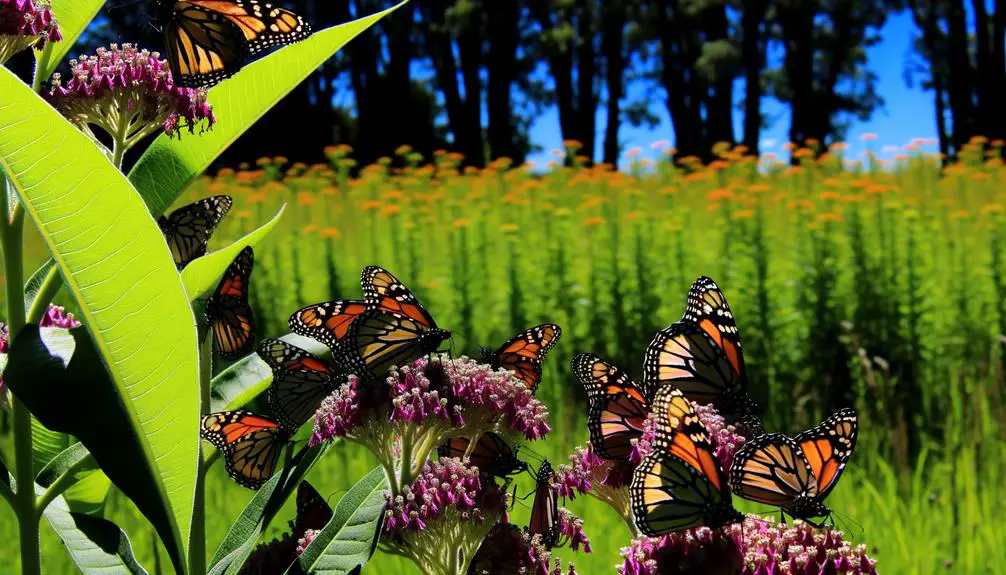10 Stunning Pictures of Monarch Butterflies Migrating
The annual migration of monarch butterflies (Danaus plexippus) spans up to 3,000 miles, encompassing North America's diverse landscapes to the oyamel fir forests in Mexico. Observed through high-resolution photography, monarchs display vivid orange and black coloration while maneuvering using celestial and geomagnetic cues.
Group formations exhibit aerodynamic efficiency and predator evasion strategies. Meteorological conditions and suitable resting spots with nectar-rich areas are critical for survival.
Dense congregations on tree branches during overwintering optimize thermoregulation. Such visual documentation provides intricate details of their migratory patterns, offering insights into the resilience and adaptability of this remarkable species.

Key Takeaways
- Monarchs form V-shaped formations and clusters during migration, optimizing energy use and providing protection.
- High-resolution images reveal monarchs' vivid orange and black wing patterns during their long migratory journey.
- Grouping behavior of monarchs in flight or roosting sites showcases their complex social and navigational strategies.
- Pictures often capture monarchs resting on oyamel fir trees, a critical habitat for overwintering.
The Journey Begins

The annual migration of monarch butterflies (Danaus plexippus) commences with millions of these insects starting on an arduous journey from their breeding grounds in North America to overwintering sites in central Mexico.
This migratory phenomenon, spanning up to 3,000 miles, is triggered by decreasing temperatures and daylight hours.
Monarchs rely on environmental cues and an innate biological compass, integrating circadian rhythms and geomagnetic fields for navigation.
These lepidopterans exhibit multigenerational migratory patterns, with successive generations completing different legs of the journey.
The initial cohort, known as the 'super generation,' demonstrates extended longevity, enabling them to travel the longest distances.
Their physiological adaptations, including lipid reserves and efficient flight mechanics, are critical for survival across diverse and challenging terrains.
Crossing Landscapes
As monarch butterflies traverse diverse terrains, they encounter numerous ecological challenges that test their resilience and adaptability.
The impact of fluctuating weather conditions can greatly alter their migration patterns, necessitating continuous adjustments.
Furthermore, their remarkable navigational instincts are essential for successful orientation and survival across varied landscapes.
Diverse Terrain Challenges
Maneuvering diverse terrains presents significant challenges to monarch butterflies during their migratory journey, demanding precise adaptation to varying environmental conditions.
These lepidopterans traverse extensive landscapes, including dense forests, arid deserts, and expansive bodies of water. Each terrain imposes unique physiological and navigational demands; for instance, forested regions require adept maneuvering through complex canopies, while deserts impose dehydration risks due to scarce water sources.
Additionally, crossing large water bodies necessitates sustained flight without rest, testing their endurance. The butterflies' ability to locate suitable roosting sites, such as oyamel fir forests in Mexico, is essential for energy conservation and survival.
Consequently, their migratory success hinges on their remarkable adaptability and resilience across multifarious terrains, underscoring the intricate interplay between biology and environment.
Weather Impact on Journey
Meteorological conditions greatly influence the migratory journey of monarch butterflies, impacting their flight patterns, energy expenditure, and survival rates. Wind patterns, temperature fluctuations, and precipitation are critical factors that monarchs must navigate.
Favorable tailwinds can greatly reduce the energy required for flight, while adverse headwinds can lead to exhaustion. Temperature extremes, both high and low, affect metabolic rates and can either accelerate or decelerate their progress. Rain can impede flight and force unscheduled landings, increasing vulnerability to predators and environmental hazards.
- Wind patterns: Tailwinds aid migration, headwinds hinder.
- Temperature fluctuations: Affects metabolic rates.
- Precipitation: Forces unscheduled landings.
- Humidity levels: Influence dehydration rates.
Understanding these variables is essential for comprehending the monarch's arduous journey.
Navigational Instincts Displayed
In their remarkable migratory journey, monarch butterflies exhibit sophisticated navigational instincts, allowing them to traverse diverse landscapes with precision.
These Lepidoptera utilize a combination of celestial navigation and geomagnetic cues to chart their path across North America. Photoreceptors in their compound eyes detect polarized sunlight, aiding in directional orientation.
Additionally, their antennae contain magnetoreceptors that sense the Earth's magnetic field, providing critical guidance. Monarchs also leverage environmental landmarks, such as mountain ranges and coastlines, to maintain their trajectory.
This intricate integration of sensory inputs and environmental feedback guarantees that they can cross forests, plains, and urban areas with incredible accuracy.
The monarch's navigational prowess underscores an innate drive for freedom, manifesting in their extraordinary migratory feats.
Resting Spots

During their extensive migratory journey, monarch butterflies seek out ideal resting spots that provide both security and sustenance.
Ideal tree perches serve as critical refuges, offering protection from predators and harsh weather conditions.
Additionally, access to nectar-rich areas is essential for replenishing energy reserves, ensuring the butterflies' endurance for the continuation of their migration.
Ideal Tree Perches
The ideal tree perches for migrating monarch butterflies are typically characterized by dense foliage and a stable microclimate, providing necessary shelter and thermal regulation. These critical resting spots mitigate the energy expenditure during long migratory journeys and enhance survival rates.
Key attributes of these perches include:
- Canopy Density: Thick foliage aids in reducing wind exposure and maintaining humidity.
- Microclimate Stability: Trees that offer a consistent temperature range are preferred.
- Elevation: Higher perches are favored to avoid ground-level predators and flooding.
- Tree Species: Certain species, such as the Oyamel fir, are particularly advantageous.
These ecological nuances facilitate the monarchs' endurance and continuity during migration, emphasizing the importance of suitable arboreal habitats.
Shelter From Predators
While the density and stability of tree perches play a pivotal role in the monarchs' migratory success, these resting spots also serve as critical shelters from predators.
The microclimatic conditions within dense foliage provide essential thermal regulation, concealing the butterflies from avian and mammalian predators. Additionally, the high tannin content in certain tree species deters herbivorous threats, further enhancing survivability.
Observations indicate that monarchs preferentially select evergreen trees such as oyamel firs, whose dense canopies offer superior camouflage. This strategic selection minimizes vulnerability during diurnal and nocturnal rest periods.
Furthermore, the communal roosting behavior amplifies the collective defense mechanisms, reducing individual predation risks. Such adaptive strategies underscore the monarchs' intricate balance between migration and predator evasion, ensuring their continued survival.
Nectar-Rich Areas
Identifying nectar-rich areas is crucial for monarch butterflies, as these locations provide critical energy resources necessary for sustaining their long migratory journeys. These areas serve as essential refueling stations where monarchs can replenish their energy reserves by feeding on the nectar of specific flowering plants.
Scientific observations have identified key factors that make certain locations particularly beneficial for monarchs:
- Floral diversity: A variety of flowering species guarantees a continuous nectar supply.
- Geographical positioning: Proximity to migratory flyways maximizes accessibility.
- Phenological synchronization: Blooming periods must align with migration timings.
- Habitat stability: Consistent availability of nectar sources over years.
These attributes make certain regions indispensable for the successful migration of monarch butterflies, underscoring the significance of habitat conservation and management.
Close-Up Shots
Capturing close-up shots of monarch butterflies reveals intricate details of their wing patterns and anatomical structures, providing invaluable data for entomological studies.
High-resolution macrophotography can magnify the scale-covered wings, displaying the vivid orange and black coloration, and characteristic vein patterns. These images allow for the examination of the microstructure of the scales, which are essential for thermoregulation and UV protection.
Additionally, close-ups of the proboscis in action, antennae, and compound eyes can offer insights into feeding behaviors and sensory adaptations.
Such detailed visual documentation aids in the identification of individual butterflies, supports genetic diversity assessments, and enhances conservation strategies by emphasizing the unique morphological traits that are critical for their survival during migration.
Group Formations

Observing group formations of monarch butterflies during migration reveals complex social behaviors and navigational strategies that are pivotal for their collective survival.
These formations, often referred to as flocks, exhibit an emergent structure that maximizes aerodynamic efficiency and predator avoidance. Monarchs utilize visual and chemical cues to maintain cohesion within the group. Such formations are not random but are influenced by several factors:
- Aerodynamic Drafting: Butterflies reduce energy expenditure by flying in V-shaped formations.
- Thermal Utilization: Groups exploit thermal columns (thermals) to gain altitude with minimal effort.
- Navigational Cues: Use of the sun's position and Earth's magnetic field.
- Predator Evasion: Safety in numbers deters predators.
This intricate choreography underscores their resilience and adaptability.
Reaching Mexico
Upon reaching Mexico, monarch butterflies congregate in the oyamel fir forests of the Trans-Mexican Volcanic Belt, relying on the microclimatic conditions of these high-altitude habitats for overwintering.
The cool, moist environment provided by these forests is essential for their survival, as it minimizes metabolic rates and conserves their fat reserves. This habitat is characterized by a unique interplay of temperature and humidity, offering a stable refuge against harsh winter conditions.
Clustering in large numbers, the butterflies form dense aggregations on tree branches, a behavior that further aids in thermoregulation and protection.
Conservation of these specific forest areas is critical, as deforestation and climate change pose significant threats to the delicate balance of this overwintering ecosystem.
Conclusion
The migration of monarch butterflies (Danaus plexippus) represents a remarkable biological phenomenon, encompassing vast distances and diverse ecosystems.
Detailed observations reveal intricate group formations and critical resting spots, essential for survival during their arduous journey.
Significantly, close-up shots provide invaluable insights into morphological adaptations.
Ultimately, the arrival in Mexico signifies a successful traversal of multifaceted landscapes, akin to a 'grand tour.'
This migration underscores the importance of conservation efforts to sustain such extraordinary natural events.






